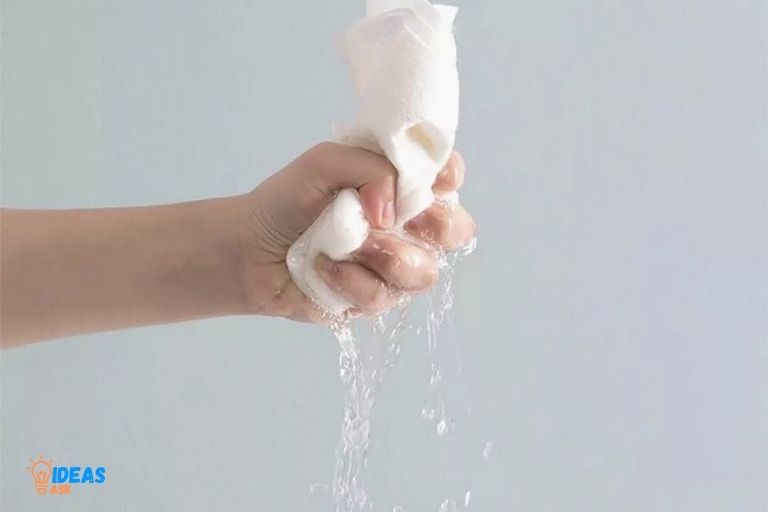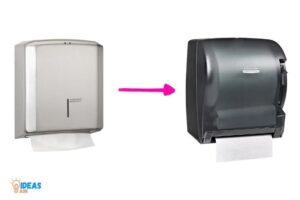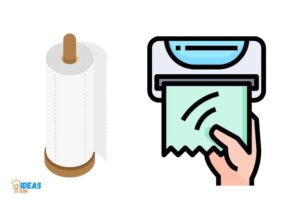How Do Paper Towels Absorb Water? Capillary Action
Paper towels absorb water through a process called capillary action, which involves the combination of adhesion, cohesion, and surface tension of the water molecules and the cellulose fibers present in the paper towel.
Capillary action is the ability of a liquid to flow through narrow spaces without the assistance of external forces like gravity.
In the case of paper towels, the cellulose fibers that make up the towel have small gaps and spaces in between them.
When these fibers come into contact with water, the adhesion between the water molecules and the cellulose fibers causes the water to spread out and be absorbed into the towel.
Additionally, the cohesion between the water molecules themselves and the surface tension of the liquid also aids in the absorption process.
Paper towels are designed with cellulose fibers that contain small gaps and spaces which facilitate the absorption of water through capillary action.
This involves the interaction of adhesion, cohesion, and surface tension between the water molecules and the cellulose fibers, allowing the water to spread out and be absorbed effectively.
Paper Towels Water Absorbency
| Property | Explanation |
|---|---|
| Absorbency | The absorbency of paper towels is due to their porous structure, which allows water to flow through the tiny spaces between fibers. |
| Capillary Action | Capillary action is the ability of a liquid to flow through small spaces without the assistance of external forces. Paper towels absorb water quickly due to the capillary action between their fibers. |
| Material Composition | Paper towels are typically made of cellulose fibers, which have a strong affinity for water as they can form hydrogen bonds with water molecules. This increases their absorbency. |
| Layer Structure | Many paper towels are made with multiple layers, which increases the available surface area to absorb water, making them more effective at absorbing larger quantities of liquid. |
| Surface Texture | Some paper towels have a textured or embossed surface, which creates more space for water to be absorbed and trapped. This can improve their overall absorbency. |
Key Takeaway

Five Facts About Paper Towels Water Absorbency
The Science Behind Paper Towels Absorbing Water
The Importance Of Paper Towels In Our Daily Lives
Paper towels are an essential part of our daily lives. From cleaning kitchen counters and wiping off any accidental spills to drying hands and removing makeup, we use paper towels all the time.
Paper towels not only help us keep our surroundings clean and hygienic but also make our daily chores easy and convenient. The absorbency of paper towels is due to the capillary action that occurs when water comes in contact with the fibers in the towel.
Here are some key points to understand the science behind how paper towels absorb water:
- The absorbency power of paper towels is due to the large surface area of their fibrous structure.
- The fibers have small spaces in between them, which create capillary action, forming a network of tiny tubes in the paper towel structure.
- When the paper towel comes in contact with water or any other liquid, the capillary action pulls the liquid inside the fibers and spreads it throughout the towel.
- The strength and quality of the paper towel’s fibers also play a vital role in how much liquid the towel can absorb.
- Paper towels are more effective than cloth towels in cleaning up spills, as the capillary action helps the towel absorb the liquid, preventing it from simply being pushed around.
- The absorbency of the paper towel is affected by the density of fibers, their size, and the overall thickness of the towel.
- To increase the absorbency of paper towels, manufacturers add special substances like sodium polyacrylate, a material that can hold many times its weight in liquid.
Overall, understanding the science behind paper towels’ absorbency can help us appreciate why they remain one of the most useful inventions in the cleaning industry.
The Composition Of Paper Towels
How do paper towels absorb water – the composition of paper towels
When it comes to cleaning up spills or messes, paper towels are a go-to for many. The absorbency of paper towels is what makes them effective, but have you ever wondered how they actually absorb the water?
The composition of paper towels plays a significant role in their absorbency capacity. Let’s take a closer look at how paper towels are made and what makes them so absorbent.
Discuss The Composition Of Paper Towels
Paper towels are made of cellulose fibers derived from wood pulp. These fibers are processed and pressed into thin sheets that are then dried, cut, and packaged.
Paper towels are a combination of both natural and synthetic fibers, including:
- Cellulose fibers
- Rayon
- Polypropylene
The exact composition of paper towels may vary between brands, but cellulose fibers are the primary component responsible for their absorbency.
Highlight How Cellulose Fibers Help In Absorbing Water
Cellulose fibers are hydrophilic, meaning they attract and hold onto water molecules. The porous nature of cellulose fibers allows water to penetrate the sheets of paper towel.
As the water is absorbed by the cellulose fibers, capillary action pulls the water through the tiny spaces and pores between the fibers.
This process is aided by the creping of the paper towel sheets, which creates a more porous structure that allows for greater water absorption.
In addition to their absorbency, cellulose fibers are also biodegradable, making paper towels an eco-friendly option for cleaning up spills and messes.
The composition of paper towels is primarily made up of cellulose fibers, which are responsible for their absorbency.
These hydrophilic fibers have a porous structure that allows for the absorption of water molecules, aided by the creping of the paper towel sheets.
So next time you reach for a paper towel to clean up a spill, you’ll know exactly how it works to absorb the water.
Mechanism Of Water Absorption In Paper Towels
How do paper towels absorb water – mechanism of water absorption in paper towels
Paper towels are a common household item used for various cleaning purposes. One of their primary uses is to absorb water, which they do with remarkable efficiency.
But have you ever wondered how paper towels absorb water? In this section, we will delve deeper into the science behind this mechanism.
Explain The Mechanism Of Capillary Action
Capillary action is the primary mechanism through which paper towels absorb water. It occurs when water is drawn into narrow spaces against gravity.
This process is due to the cohesion and adhesion properties of water molecules, which enable them to stick together and to other surfaces.When a paper towel comes in contact with water, the fibers within it create narrow spaces or capillaries.
These capillaries pull water up through the towel, aided by the adhesive forces between water molecules and paper towel fibers. The narrowness of the capillaries also helps to support the water column, preventing it from collapsing.
Elaborate On How Capillary Action Helps Paper Towels Absorb Water
Capillary action is what makes paper towels absorb water so effectively. Here are some key ways this process helps.
- Efficient absorption: Capillary action allows water to be drawn quickly and effectively into the paper towel. This means that paper towels can absorb large amounts of water in just a few seconds.
- Wicking: When water is absorbed through capillary action, it moves through the fibers of the paper towel to wet a large surface area. This enables the towel to remove water very effectively from surfaces.
- Strength: The capillaries formed in the paper towel through capillary action help to support the water column. This means that the towel is less likely to break, even when wet.
- Versatility: Capillary action is a very versatile mechanism, which makes it ideal for a range of water-absorbing applications. Paper towels, for example, can be used to absorb water from a variety of surfaces, including floors, countertops, and dishes.
Capillary action is the primary mechanism through which paper towels absorb water. This process enables paper towels to absorb large amounts of water quickly and effectively, making them a valuable tool for many cleaning applications.
Factors Affecting Water Absorption Capacity Of Paper Towels
How Do Paper Towels Absorb Water
When it comes to cleaning up spills or messes around the house, paper towels are a reliable option. But have you ever thought about how they absorb water? Let’s take a deeper look at the factors affecting the water absorption capacity of paper towels.
Factors That Affect The Water Absorption Capacity Of Paper Towels
Thickness
The thickness of paper towels plays a significant role in their water absorption capacity. Thick paper towels can hold more water than thin ones. This is because the thickness allows more fibers to be packed into the towel, creating more empty spaces to hold water.
Texture
The texture of paper towels also affects their water absorption capacity. Paper towels with a rough texture can absorb and hold more water than smooth ones.
This is because the rough surface provides more surface area for the water to cling onto, thereby preventing the water from sliding off.
Ply
The ply of paper towels refers to the number of layers in a towel. Generally, paper towels’ water absorption capacity increases as the number of plies increases. This is because the plies trap more water, preventing it from seeping through so quickly.
In addition, paper towels with more plies tend to be stronger and more durable, making them ideal for more substantial spills and messes.
Overall, the thickness, texture, and ply of paper towels significantly affect their water absorption capacity. Understanding these factors when purchasing paper towels can help ensure you choose the best towels for your needs.
So next time you grab a paper towel to clean up a spill, take a moment to appreciate the design that helps them absorb water.
Comparing Paper Towels To Other Absorbent Materials
When it comes to absorbent materials, paper towels are the clear winner. Comparing them to other alternatives like cloth, cotton, and sponges reveals why.
Cloth
- Cloth is made from natural or synthetic fibers and can absorb liquid, but when compared to paper towels, it isn’t as effective.
- The woven fibers in cloth can trap particles and cause it to become dirty and less absorbent over time.
- Cloth also requires laundering and additional chemicals to clean, which can be harmful to the environment.
Cotton
- Cotton is a soft, fluffy material that is highly absorbent, but compared to paper towels, it falls short.
- Cotton towels do absorb liquid quickly, but they often leave streaks and can be difficult to wring out.
- Cotton also requires a lot of water to grow and process, making it less sustainable than paper towels.
Sponges
- Sponges are a common household cleaning tool, but they aren’t the best for absorbing liquid.
- Sponges are porous and can trap bacteria, making them a less hygienic option.
- Sponges can also be difficult to rinse out, and over time, they hold onto more bacteria and germs.
Why Paper Towels Are Better At Absorbing Water Than Other Alternatives
Compared to other absorbent materials like cloth, cotton, and sponges, paper towels are superior for several reasons.
Instant Absorption
- Paper towels are designed to absorb moisture instantly, preventing large spills or messes from spreading further.
- The material used in paper towels is soft yet durable, allowing it to absorb more liquid in a shorter amount of time than any other alternative.
No Germs
- Because paper towels are a single-use item, they don’t harbor bacteria or germs like other absorbent materials.
- After use, paper towels can be thrown away, making them a more hygienic option than other alternatives.
Ease Of Use
- Paper towels come in a variety of sizes, making them versatile enough to handle any mess big or small.
- With just one sheet of paper towel, you can quickly and easily tackle any spill or mess.
Paper towels are the superior choice when it comes to absorbent materials. They are designed specifically for quick and easy absorption, while other alternatives fall short.
They’re a more hygienic option and generally easier to use, making them a better choice for any household or business.
FAQ About Paper Towels Water Absorbency
How Do Paper Towels Absorb Water?
Paper towels absorb water through capillary action, which is the ability of water molecules to stick to other substances.
Why Are Paper Towels Used To Clean Spills?
Paper towels are used to clean spills because they are absorbent and can easily pick up the liquid from a surface.
Are Paper Towels Better Than Cloth Towels?
Paper towels are better for cleaning up spills because they are disposable and more hygienic than cloth towels.
How Can Paper Towels Be More Eco-Friendly?
To make paper towels more eco-friendly, look for those made from recycled paper or switch to reusable cloth towels.
Conclusion
Paper towels are highly absorbent due to their structure and composition. They are made of soft and flexible fibers that create spaces for water to penetrate and be captured. Additionally, they contain chemicals that enhance their absorbency and help break surface tension, allowing water to spread and saturate the towel quickly.
The interlocking fibers and capillary action allow paper towels to hold on to the water and prevent it from dripping or leaking. Finally, the embossing patterns on the surface of paper towels increase the surface area and help to increase the absorbency rate even further.
Overall, paper towels continue to be a reliable and convenient solution for dealing with spills and messes in our daily lives. So next time you reach for a paper towel, remember how it works to make your life easier!



